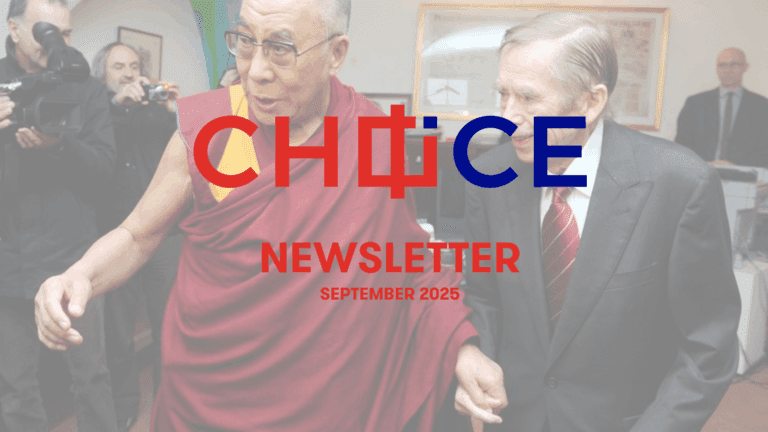Dissecting the Confluence of China and Russia’s Propaganda Efforts in Central Europe

With the war in Ukraine dominating the media headlines, China’s reaction to the Russian invasion has merited close attention. While continuously proclaiming the respect for sovereignty and territorial integrity, the complex nature of the situation, and the importance of peace negotiations, Beijing’s emphasis on ostensible neutrality stands in stark contrast with the pro-Kremlin narratives amplified by both Chinese officials and state-controlled media.
The level to which China disseminates disinformation regarding, for instance, the alleged US biolabs in Ukraine and recently also denying the atrocities conducted by the Russian soldiers in Bucha and elsewhere, provides a key example of growing confluence between China and Russia’s external propaganda.
‘Alternative’ Perspectives
Yet, the narrative convergence between China and Russia has not appeared out of nowhere. Despite China and Russia’s external propaganda operating differently, with distinct objectives and tools, in the case of Central Europe, their efforts converge in certain respects, such as using similar channels to spread their message and targeting a similar audience.
Such a confluence of Chinese and Russian narratives is evidenced by the recent MapInfluenCE analysis, tracking pro-Chinese narratives and depiction of five key China-related topics (5G, Chinese investment, Hong Kong protests, Xinjiang and Taiwan) in six Czech and Slovak alternative media between 2020 and 2021. The research shows that alternative media websites serve as important platforms featuring pro-Chinese narratives and echoing China’s official views on crucial issues to local audiences.
In the Czech and Slovak context, the term ‘alternative’ refers to media that challenge established channels and present alternative approaches and perspectives that contradict or diverge from the dominant discourse, in effect often promoting unreliable or fake information. The ‘alternative’ character of the media may also be identified not only in terms of the content but also in the employment of ‘clickbait’ methods or lack of compliance with basic ethical and journalistic standards.
The alternative media websites in Czechia and Slovakia show various logic of functioning, with some of them being strongly motivated by profit. The range of topics they focus on is fairly broad, ranging from health and illness treatment disinformation (including COVID-19) to coverage of world events. Due to the cultural and linguistic affinity, the Czech and Slovak alternative media system is largely intertwined, with the media often reposting each other’s articles.
The media selected for analysis are well-established (for instance, Parlamentní listy have been active at least since 2009) and known for their long-term non-critical adoption of pro-Russian and anti-system narratives. On the other hand, with the obvious exception of Sputnik, evidence that would directly link the media to Russia is largely absent.
Viewing China through the US-China Competition
Yet, hints about the cooperation between Chinese media and local alternative or fringe media in the Czech Republic and Slovakia have already been uncovered before. For instance, the Czech alternative web AC24 appears to have content-sharing cooperation with the Czech version of Czech Radio International (CRI). Chinese Ambassadors in the Czech Republic and Slovakia have also often published op-eds/uncritical interviews in alternative media such as Parlamentní Listy and Hlavné správy in the Czech Republic and Slovakia, respectively.
The coverage of China-related topics in the alternative media in the two countries is, however, usually more subtle and there is no proven direct link to Chinese state actors. The evidence gathered from the MapInfluenCE analysis suggests that the alternative media often reprint texts provided by local press agencies, which then enables them to smuggle in the ‘alternative points of view’ they profess to present. This may easily translate into direct reprinting of information provided by Chinese or Russian official sources. While the official discourse has understandably its place in the media coverage, lack of context, which is often the case in the analyzed alternative media, may severely distort the perceptions of the reader.
In general, the analyzed alternative media prominently feature foreign voices, including those from China and Russia, often to the detriment of the local expertise. For instance, a detailed look at the analysis of the 5G buildup shows that 24 percent of the quoted experts were from China and 14 percent from Russia. However, this is only one of the manipulative techniques these media use to alternate the narratives. As the case studies in the detailed study show, the analyzed media may choose to omit certain information or smuggle in specific quotes taken out of context.
The analysis also found evidence of localization of pro-Chinese discourse. For example, the alternative media published comments of several Czech stakeholders comparing Taiwan to “Sudetenland”, the Czech borderland with Germany and Austria occupied and integrated by the Third Reich Nazi Germany in 1939, while explaining China’s unfavorable attitude towards the President of the Czech Senate Miloš Vystrčil’s official visit to Taiwan in September 2020.
The coverage of the analyzed China-related topics also shows the frequent occurrence of subthemes related to the US-China relations, frequently completely omitting any local aspects of the discussion. This finding is to some extent rooted in the tendency to reprint articles from other media (including other language variations in the case of Sputnik Czech Republic), but it also suggests that the analyzed alternative media may view topics related to China primarily through the lens of the US-China competition. Consequently, the media may be prone to publishing China’s views, especially when the official proclamations fit into their overall strategy of promoting anti-US and anti-West attitudes.
Shouldering the Burden
It is now clear that Beijing and Moscow see each other as crucial partners in their efforts to redefine the nature of the world order which they seek to be better tailored to the needs of non-Western countries. Although the exact character of the sought arrangement and steps to achieve it remain rather opaque, related external propaganda efforts to dismantle and discredit the existing international system are converging. Since 2013, Russian and Chinese media have signed several content-sharing agreements, with just Sputnik concluding 17 such deals.
In the context of the war in Ukraine, several Czech and Slovak alternative media websites, including some of those analyzed by MapInfluenCE, were temporarily blocked due to risks to national security. Whereas in Slovakia, the website Hlavné správy was blocked on the basis of a new law aimed at limiting the spread of disinformation, in the Czech Republic it was CZ.NIC, a private domain provider, deciding to proceed with this step, allegedly based on recommendations of Czech intelligence services. Such an unprecedented set of measures emphasizes the need of establishing a complex legal framework to address the challenge but also sends a crucial signal to alternative media and foreign actors using these media to spread their messaging.
Still, some of the blocked media promptly adapted to the new environment, switching to different domains, disseminating articles on Facebook, or creating closed Telegram groups, which are more difficult to monitor. These developments further underlined the advantages of sharing propaganda channels between China and Russia as Chinese media and their social media accounts proceeded to disseminate pro-Kremlin narratives regarding the war in Ukraine. As the latest CHOICE research on the dissemination of Chinese narratives on the invasion in Central and Eastern Europe shows, CRI has actively promoted anti-US and anti-NATO narratives and Russia‘s justification of the war.
Benefits of Sharing the Boat
While China is now effectively helping Russia spread some of its messages, even if out of self-interest, it may be actually Beijing who will benefit more from the cooperation. In Central Europe, China’s efforts have so far not reached the intended audience. For instance, the traffic on the Czech language website of CRI has seen below 50,000 visits per month, with the actual number potentially being much lower since the tracking engine does not consider websites of such low traffic. On the contrary, the Czech version of Russian Sputnik got almost 2.5 million visits in January, growing to 3.9 million in February. Thus, using already established alternative media channels may contribute to amplifying China’s official views.
Besides increased reach to the local population, China’s propaganda may also profit from more sophisticated content, which has been a trademark of Russia-linked platforms. As evidenced by a recent MapInfluenCE analysis of Polish versions of Sputnik and CRI, original articles published by CRI usually appear unconvincing due to poor editing and linguistic errors, potentially caused by mechanical translation from other language versions. As the case of the plausible cooperation between CRI and AC24 in the Czech Republic shows, collaboration with local alternative media may result in better-articulated positions and set the Chinese messaging into an already established manipulative media ecosystem.
Given all the advantages of coordination of China’s and Russia’s propaganda efforts and also the existing nexus of cooperation, further convergence in terms of using similar channels and spreading mutually beneficial narratives may be anticipated, especially on issues where the aims of the two powers intersect. Thus, the narrative convergence on Ukraine will most likely not be a one-time development, but a step towards even closer cooperation on bolstering ‘discourse power.’
Written by
Veronika Blablová
Veronika Blablová is an analyst at CEIAS.


